Behind the Scenes of KRRR! with Ivan Školuda |
Read more at in70mm.com The 70mm Newsletter |
| Written by: Ivan Školuda, Slovak Republic | Date: 12.01.2024 |
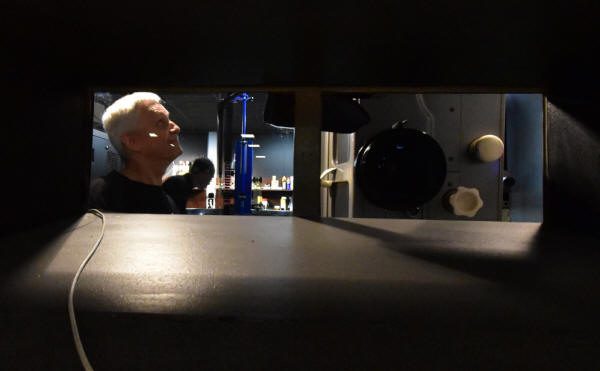 Ivan
Školuda at the 70mm projector, Kino Mir 70. Picture: Thomas Hauerslev Ivan
Školuda at the 70mm projector, Kino Mir 70. Picture: Thomas HauerslevThis probably won't surprise you, but if you are expecting anything about festival preparation, accreditations, press materials, promotion, transporting film prints and things like that … I can't tell you anything at all! You will have to contact either Marcela Procházková, or the head of the cinema, or Martin Bodešínsky, who also helps me with the screenings, or Petra Pokorná, who does help with projection, but is also in charge of promotion. In fact, I would like to take a moment to acknowledge all the staff of this cinema, who do a tremendous job for the festival. I can only tell you about little things, like which films we'll put in the programme, and the logistical and technical issues some of them presented. Plus, I'll be on duty projecting sometimes, so I won't always have a chance to get down here to tell these stories about the shows. I hope that these will be enough for you and that you’ll be satisfied! I should start with the "dramaturgy" [programming structure – ed., and see footnote*] of the festival. Pavel Tomešek, whenever he was interviewed somewhere, was always asked how he does the dramaturgy of the festival.
The main reason I'm standing here today is
to give a lecture, we've already covered that in the introduction. When I’m
projecting, it's a bit inconvenient for me to come down here before the show
and actually give you a talk, and then have to quickly run off to the
projection room. And I know that not everybody's interested. I'm surprised
that so many of you are interested in the technical stuff. We are doing an
experiment this year where we're going to cram these stories all into one
presentation. You might be disappointed to learn something about movies
you've already seen, something that you might have noticed - or maybe didn't
- but it's supposedly an experiment, so let’s experiment. It'll make my life
easier this weekend, so let’s give it a try. |
More in 70mm reading: Slovak: Ze Zákulisí KRRR! s Ivan Školuda Slides Gallery: Behind the Scenes of KRRR! with Ivan Školuda 7OMM Seminar at Kino Mir 70 in Text and Image 16th 70mm Film Seminar, KRRR! Home of Panoramic Film Presentation in Banská Bystrica in70mm.com's Library Presented on the big screen in 7OMM Peripheral Vision, Scopes, Dimensions and Panoramas |
 As
our first screening, you saw the French film
"The Second Truth", which we had borrowed from Ukraine.
That copy arrived before 2019 and was actually supposed to be the opening
film for our 15-year anniversary Festival in 2020, which got cancelled
because of Covid-19. And of course, the soundtrack was in Russian, while the original
dialog was in French. We always try to screen films in the original, so we
decided right from the beginning not to have that Russian sound in there.
The other problem we had was whether we would screen it at all, because that
print was very battered, quite worn out. We assume there were probably quite
a lot of screenings in the East at the time it first came out. You saw
it, there were certainly a lot of splices and so on. I mean, we had a few
problems with it, but eventually we were able to screen it. This was the
first print that we immediately decided had to be converted to the original
French sound. We contacted friends in France to see if they could get us a
DVD, or a BluRay to use as an audio source. We were horrified to find out
that this film was not even released on digital media in France. Eventually
we managed to get hold of a copy on VHS. But it had two problems: 1) the
sound was mono, and, 2) on that French VHS version, one full scene that was
in the Ukraine print was missing completely! So, if you happened to be there
for the screening, you may have noticed the brief sequence in which they
were speaking in Russian. Just that bit was missing in the French tape. And what
we tried to do, but which of course is not very easy to do, we tried to
spread the mono track into 8 channels. Admittedly the film was in mono, but
somehow we got it so all the speakers were maybe playing a little bit. As
our first screening, you saw the French film
"The Second Truth", which we had borrowed from Ukraine.
That copy arrived before 2019 and was actually supposed to be the opening
film for our 15-year anniversary Festival in 2020, which got cancelled
because of Covid-19. And of course, the soundtrack was in Russian, while the original
dialog was in French. We always try to screen films in the original, so we
decided right from the beginning not to have that Russian sound in there.
The other problem we had was whether we would screen it at all, because that
print was very battered, quite worn out. We assume there were probably quite
a lot of screenings in the East at the time it first came out. You saw
it, there were certainly a lot of splices and so on. I mean, we had a few
problems with it, but eventually we were able to screen it. This was the
first print that we immediately decided had to be converted to the original
French sound. We contacted friends in France to see if they could get us a
DVD, or a BluRay to use as an audio source. We were horrified to find out
that this film was not even released on digital media in France. Eventually
we managed to get hold of a copy on VHS. But it had two problems: 1) the
sound was mono, and, 2) on that French VHS version, one full scene that was
in the Ukraine print was missing completely! So, if you happened to be there
for the screening, you may have noticed the brief sequence in which they
were speaking in Russian. Just that bit was missing in the French tape. And what
we tried to do, but which of course is not very easy to do, we tried to
spread the mono track into 8 channels. Admittedly the film was in mono, but
somehow we got it so all the speakers were maybe playing a little bit. |
|
 The
second film
“Mutiny on the Bounty” is the original distribution print for
the country Czechoslovakia. We had a screening agreement a year in advance. When it got here, we found
out that what we hoped for was, in fact, true: it was an original Ultra
Panavision print. That made us happy because we wanted to play Ultra
Panavision. Since we only have one lens for Ultra Panavision, we didn't want
to give you too many interruptions on such a long film, so we played it from the
platter. Maybe some people noticed. The film had color loss (fading) , but
it was a roadshow. The biggest shock for us, because we had a this copy was
from the Czech Republic, was that it had Slovak subtitles! We had no
previous idea about that, either. So if anybody thought I had forced Slovak
subtitles on this film, nope, it wasn’t my doing! The
second film
“Mutiny on the Bounty” is the original distribution print for
the country Czechoslovakia. We had a screening agreement a year in advance. When it got here, we found
out that what we hoped for was, in fact, true: it was an original Ultra
Panavision print. That made us happy because we wanted to play Ultra
Panavision. Since we only have one lens for Ultra Panavision, we didn't want
to give you too many interruptions on such a long film, so we played it from the
platter. Maybe some people noticed. The film had color loss (fading) , but
it was a roadshow. The biggest shock for us, because we had a this copy was
from the Czech Republic, was that it had Slovak subtitles! We had no
previous idea about that, either. So if anybody thought I had forced Slovak
subtitles on this film, nope, it wasn’t my doing! |
|
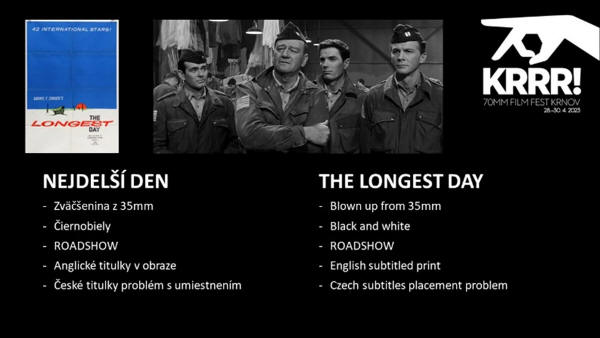 This
afternoon you will see the film
"The Longest
Day". It's a film which is from an era when such older prints
often have color fading, but since it's in black and white, it's not red,
it's really going to be in black and white. There won't even be a hint of
red. We will be screening the film classically as a roadshow. But since it's
a blow-up, there's a subtitling dilemma. The film is multilingual and the
scenes that are spoken by Germans, French and so on have English subtitles
already burned in on the print, so English people will understand. The only
problem is that those English subtitles are almost halfway up into the
picture area. We had a problem putting our Czech ones in there along with
the English titles. We managed to squeeze them in a little bit. I hope you
will be able to read it and that you will be pleased with the result. This
afternoon you will see the film
"The Longest
Day". It's a film which is from an era when such older prints
often have color fading, but since it's in black and white, it's not red,
it's really going to be in black and white. There won't even be a hint of
red. We will be screening the film classically as a roadshow. But since it's
a blow-up, there's a subtitling dilemma. The film is multilingual and the
scenes that are spoken by Germans, French and so on have English subtitles
already burned in on the print, so English people will understand. The only
problem is that those English subtitles are almost halfway up into the
picture area. We had a problem putting our Czech ones in there along with
the English titles. We managed to squeeze them in a little bit. I hope you
will be able to read it and that you will be pleased with the result. |
|
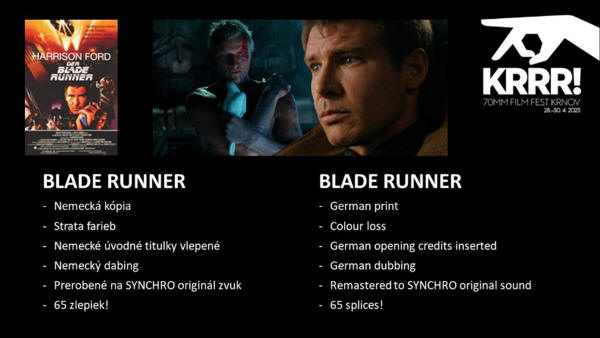 The
“Blade Runner” movie has a very interesting history. We've wanted to
play it for a long time, we've had our eyes on it for a long time. I'm
telling you up front so I don't have to come in before the movie, this print
is really faded to red completely. The film print sound is German. If you're
wondering which version it is (because there were several versions
released), it's basically the American theatrical version, which the Germans
have modified in such a way that they've actually cut the opening credits.
Those opening explanatory credits, which are present normally, are
cruelly cut out of the film print and replaced by their German credits,
which have a different font and look completely different. Something is
“wrong”, like it doesn't belong there. And then, of course, they put the
speaking in German, dubbed over the full length of the magnetic track. I
can't judge the German dubbing, but having seen the film, since I know the
film by heart in English, somehow the German dubbing didn't seem as good as
some dub jobs and didn’t “fit”. We had already determined at that earliest
stage of planning that it was a problem, what to do with the German dubbing.
But at that time we hadn’t developed our technical system to do the synchro
yet. This year, when we had already decided that we were actually going to
run this show, the decision was clear. This will be the second film where
the synchro sound is deployed against the original version on the print.
This film of course was a huge success in the cinemas in its day, so it is,
again, in a terrible, downright disastrous state. There are up to 65 splices
throughout the whole length of the print, so those who have seen it before
will have to determine for themselves whether it is too much or too little.
It is a lot. The
“Blade Runner” movie has a very interesting history. We've wanted to
play it for a long time, we've had our eyes on it for a long time. I'm
telling you up front so I don't have to come in before the movie, this print
is really faded to red completely. The film print sound is German. If you're
wondering which version it is (because there were several versions
released), it's basically the American theatrical version, which the Germans
have modified in such a way that they've actually cut the opening credits.
Those opening explanatory credits, which are present normally, are
cruelly cut out of the film print and replaced by their German credits,
which have a different font and look completely different. Something is
“wrong”, like it doesn't belong there. And then, of course, they put the
speaking in German, dubbed over the full length of the magnetic track. I
can't judge the German dubbing, but having seen the film, since I know the
film by heart in English, somehow the German dubbing didn't seem as good as
some dub jobs and didn’t “fit”. We had already determined at that earliest
stage of planning that it was a problem, what to do with the German dubbing.
But at that time we hadn’t developed our technical system to do the synchro
yet. This year, when we had already decided that we were actually going to
run this show, the decision was clear. This will be the second film where
the synchro sound is deployed against the original version on the print.
This film of course was a huge success in the cinemas in its day, so it is,
again, in a terrible, downright disastrous state. There are up to 65 splices
throughout the whole length of the print, so those who have seen it before
will have to determine for themselves whether it is too much or too little.
It is a lot. |
|
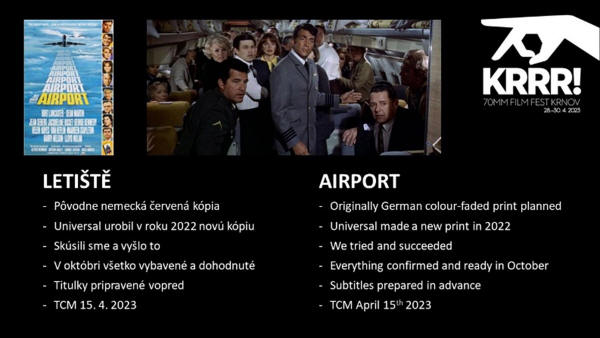 Now
we come to the film
“Airport”.
Universal made a brand-new print around the middle of 2022. So we decided
that we weren't going to play the red-faded magnetic sound version of "Airport"
if we were going to be able to play this nice new copy. We called the
bookers who provide copies from Universal to see if they would agree to
lend us the print. But it seems there's exactly one single print available, and
when there's only one single print, getting it to Europe at all is a huge
problem. Well, what surprised us was that we got an answer back in no time:
"Yes Okay, no problem. You can have it." So we basically knew in
October that we were going to play the new "Airport". Of
course, then it got a little bit more complicated. One day, we got a call
that the TCM Classic Film Festival [TCM = “Turner Classic Movies” TV cable
channel – ed.] wanted to screen it in Los Angeles on 15-04-23, and when you
do the math from April 15th to our show date of Friday, April 28, and are
aware of the many ways things can go wrong in shipping on a tight schedule …
we began to get cold feet. We were worried that actually the film that we
had selected so early on might not even be able to play at all. Of course,
we exchanged messages several times. We asked how it was going to be, if it
would be able to come and they promised us, holy shit, that yes, they would
make it happen, and not to worry. Well, you saw for yourself yesterday that
they did make it! But we insured ourselves just in case the film didn't
arrive at the last minute, for example in case the Czech customs wouldn't
let it through, or in case there was a technical problem: we had a 35mm
Technicolor print with a genuine 4-track original magnetic sound recording
ready for you. You would have seen it in the dye-transfer colour process,
with no fading, maybe as good color as you saw with that 70mm print. Now
we come to the film
“Airport”.
Universal made a brand-new print around the middle of 2022. So we decided
that we weren't going to play the red-faded magnetic sound version of "Airport"
if we were going to be able to play this nice new copy. We called the
bookers who provide copies from Universal to see if they would agree to
lend us the print. But it seems there's exactly one single print available, and
when there's only one single print, getting it to Europe at all is a huge
problem. Well, what surprised us was that we got an answer back in no time:
"Yes Okay, no problem. You can have it." So we basically knew in
October that we were going to play the new "Airport". Of
course, then it got a little bit more complicated. One day, we got a call
that the TCM Classic Film Festival [TCM = “Turner Classic Movies” TV cable
channel – ed.] wanted to screen it in Los Angeles on 15-04-23, and when you
do the math from April 15th to our show date of Friday, April 28, and are
aware of the many ways things can go wrong in shipping on a tight schedule …
we began to get cold feet. We were worried that actually the film that we
had selected so early on might not even be able to play at all. Of course,
we exchanged messages several times. We asked how it was going to be, if it
would be able to come and they promised us, holy shit, that yes, they would
make it happen, and not to worry. Well, you saw for yourself yesterday that
they did make it! But we insured ourselves just in case the film didn't
arrive at the last minute, for example in case the Czech customs wouldn't
let it through, or in case there was a technical problem: we had a 35mm
Technicolor print with a genuine 4-track original magnetic sound recording
ready for you. You would have seen it in the dye-transfer colour process,
with no fading, maybe as good color as you saw with that 70mm print.When the "Airport" print arrived, of course we played it for a test run, subtitles and all. But then we observed that there was a huge quality difference in the sound between what was on the magnetic print and what we heard coming through from the DATASAT discs. We decided, we can't play you this demonstration, that we just can't do that because you'd stone us! Why are we playing you such terrible sound when the copy we had on the 35 is full-range, and the old 70 used to sound wonderful.? And it was clear what we had to do: we took that sound from the 35mm magnetic four-channel copy and we used it with the 70mm print. That's not a problem because there's a DATASAT synchro code there, so there are no gaps or anything. So this presentation of what you saw of "Airport" yesterday, I think you witnessed the only show ever of this 70mm print with magnetic sound recording. Nobody else in the world will see it like that. Probably, unless somebody else does it too! And we found out some other interesting things during that audio preparation: On that 70mm print, there were three shots missing compared with the 35mm print. It’s only about 15 seconds total, and of course completely meaningless. Just the main character says a sentence, gets up to leave, closes the door and walks away. The scene where he leaves and closes the door is not there in the new 70mm copy. We don’t know why the shots are missing, but they are. Insignificant, but they weren't there. And one other challenge we faced was that actually, where any splices were on the 35mm print, we would be missing a piece of sound. To fill those little gaps, I took the corresponding sound bits from that DATASAT 70mm print, so if anybody noticed that there was a different sound for a moment (it was often on some actress's line of dialog, it seemed), it was because of that. Obviously we tried to adjust the levels so that it would match, and it would be right on a cut, so you wouldn’t get just half a sentence. There were three moments like that, that's how DATASAT's new modern digital sound was modified. What made the biggest difference in the sound? Well, just so you know, the thing that was most different was that the DATASAT sound had almost no bass at all, it had no dynamics at all. Just the loud scenes and the quiet ones were more or less exactly the way sound is done today, that's how it was done. The even bigger and more significant change, which just completely shocked us and that we had to do sound replacement for, were the scenes where in "Airport" they would split the images in two (“split screen”) and there was an actor on one side and an actress on the other side, e.g. the husband and wife who were arguing and so on. And there were more scenes like that. In the DATASAT audio that came in, these scenes were in mono for some reason, playing only in the center channel. On the magnetic print, these scenes were nicely mixed, from left to right as they walked around, as you may have noticed. But for unknown reasons, it wasn't like that on the DATASAT disc, they were all mono. Okay, I've probably sufficiently talked about this movie, but actually I wanted to add one more comment. At this festival in America where “Airport” was screened, and where we were afraid it would not arrive from, they played a very large number of films. This that you see on the screen [motioning to a listing on the screen; see image #9 in the associated photo gallery – ed.] is just a narrow, really narrow listing of some of the films played during the festival. When I was looking [at the list] I was saying to myself, as a projectionist, “this is great!” I would have enjoyed it, such a huge number of titles to prepare, to screen, to see. You can see that many of the films are very good. So I looked into the specifications of formats and that kind of thing. Well, you cannot guess how many of these titles they played in digital and how many from analogue prints. But I will tell you, without you having to guess: they played two films from analogue prints, and all remaining ones came from digital. One which was from a film print is clear, it was “Airport”, of course, along with “The Wild Bunch”. As you can see there they played Amadeus too, of course the Director's Cut, from DCP. So this is [my comment] on this brilliant festival, which indeed had an excellent program. And these are not all the films there, I am just showing the ones I would have liked to see, not everything. |
|
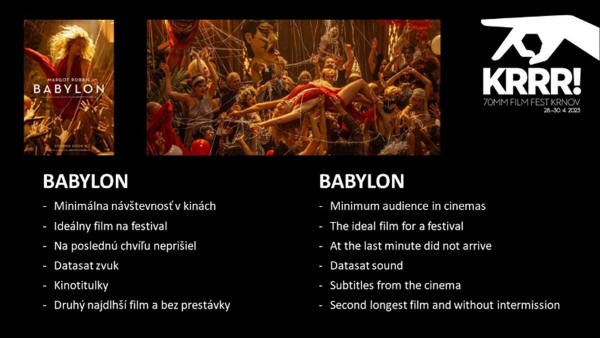 We
were to see and screen the movie "Babylon", which I'm sure you were
all looking forward to. Then, after we had agreed that the film would come
for the festival, it was rather widely released in digital mode, even here
in Krnov. We watched it to see if it was suitable for this festival. If any
of you have at least read what it is about, you already know this film is
absolutely right for this festival. This one is so fitting for us! Our hopes
and expectations were dashed. We thought we had it fully arranged, but just three days before the festival, Paramount notified us that due
to a "scheduling conflict" it couldn't be delivered; and they couldn't send
the print to us from the studio, so I'm terribly sorry about that and we
apologize. If we can try to arrange it for next year, we will do so. It has
disrupted the whole concept, the dramaturgy, for us this year. Anyway, So
much for this film. We
were to see and screen the movie "Babylon", which I'm sure you were
all looking forward to. Then, after we had agreed that the film would come
for the festival, it was rather widely released in digital mode, even here
in Krnov. We watched it to see if it was suitable for this festival. If any
of you have at least read what it is about, you already know this film is
absolutely right for this festival. This one is so fitting for us! Our hopes
and expectations were dashed. We thought we had it fully arranged, but just three days before the festival, Paramount notified us that due
to a "scheduling conflict" it couldn't be delivered; and they couldn't send
the print to us from the studio, so I'm terribly sorry about that and we
apologize. If we can try to arrange it for next year, we will do so. It has
disrupted the whole concept, the dramaturgy, for us this year. Anyway, So
much for this film. |
|
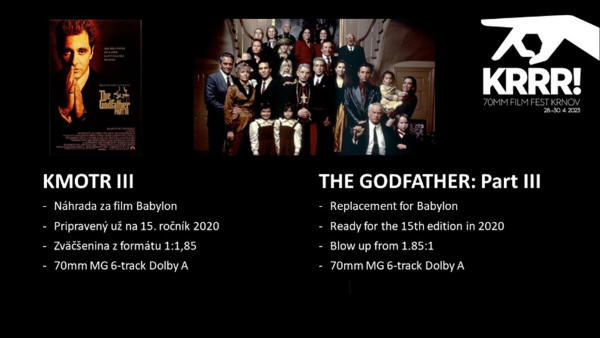 In
place of the missing “Babylon”, we're going to play the film
“The Godfather Part III”, which we had already prepared for the 15th
year edition, which we had envisioned as a four-day series. But when our
15th edition became instead a three-day event, it was one of the films we
had to eliminate. Coincidentally, “Godfather III” is also from
Paramount. It's going to play today, obviously. It's 1:1.85 and it's the
only film this year that's not the full screen width. Also, it's got Dolby A
magnetic sound, the only film this year with Dolby A. The other films are 6
channel without Dolby. So much for today's shows. The film, you'll see for
yourself, it's pretty dark but the print is nice, you'll be happy and it's in color. By which I mean, it’s not faded to pink or red. In
place of the missing “Babylon”, we're going to play the film
“The Godfather Part III”, which we had already prepared for the 15th
year edition, which we had envisioned as a four-day series. But when our
15th edition became instead a three-day event, it was one of the films we
had to eliminate. Coincidentally, “Godfather III” is also from
Paramount. It's going to play today, obviously. It's 1:1.85 and it's the
only film this year that's not the full screen width. Also, it's got Dolby A
magnetic sound, the only film this year with Dolby A. The other films are 6
channel without Dolby. So much for today's shows. The film, you'll see for
yourself, it's pretty dark but the print is nice, you'll be happy and it's in color. By which I mean, it’s not faded to pink or red. |
|
 Another
film that we're going to play that has turned out to be very very, very
problematic is
“Titanic”. We had tried to screen it here in Krnov in 2012. We had
been granted the rights then, but we ultimately had to screen a digital
version. I myself, where I work in
Banská Bystrica, when we
screen at the summer cinema, I had tried for this film for several years and
they never granted the rights. Last year we did a James Cameron series. We
played almost all of his films, except “Titanic”, which they would
not grant us the rights to screen. But this year, there has been a
special screening opportunity worldwide on the occasion of the 25th
anniversary of the original release. I leaped at the chance to grab it,
because it was the only way we could officially show the film on 70mm with
the rights here at this festival. Another
film that we're going to play that has turned out to be very very, very
problematic is
“Titanic”. We had tried to screen it here in Krnov in 2012. We had
been granted the rights then, but we ultimately had to screen a digital
version. I myself, where I work in
Banská Bystrica, when we
screen at the summer cinema, I had tried for this film for several years and
they never granted the rights. Last year we did a James Cameron series. We
played almost all of his films, except “Titanic”, which they would
not grant us the rights to screen. But this year, there has been a
special screening opportunity worldwide on the occasion of the 25th
anniversary of the original release. I leaped at the chance to grab it,
because it was the only way we could officially show the film on 70mm with
the rights here at this festival.But then another problem came up with this film. The initial audience response to the re-issue of the film was less than expected, so that as of April 1, the distributor Disney cut back the available dates, stating that the film was no longer going to be available in theaters, and they rescinded the rights to show it! So it looked like, once again, it wasn't going to be able to be shown here, either. But the head of the distribution company in the Czech Republic has arranged an exception for us here in Krnov. So we have a special exception, just for us, and we can legally screen it. The print has been brought in from Denmark. It arrived here just yesterday, and they will take it away as soon as the festival is over, because it is stored in safe conditions and needs to be returned to storage as soon as possible. You will be very happy with the print, it is as good as new. It's absolutely beautiful. It does have Danish subtitles. We managed to add the Czech subtitles in there as well, so I guess they will fit, it won't be quite as consistently-located as the other prints, but there will be Czech subtitles. |
|
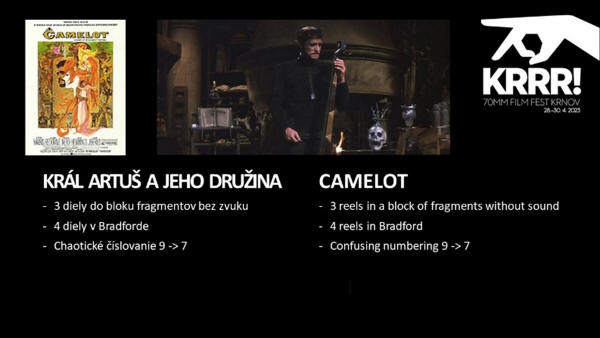 This
morning you have seen movie "Camelot" (known in CZ as: "King
Arthur and his Retinue"). It has a long history, I can talk hours on
this film. My colleague who prepares the program with me, Michal Mraz
managed to get some fragments (70mm reels) of this film a few years ago.
Pavel projected them here in Krnov and we have seen the picture is pretty
good, however the sound basically was not there, the print must have been
stored somewhere close to a magnetic field. So we had a few reels of
"Camelot" without sound and at that time we didn't have any sound
synchronization system. We considered to show those as fragments but these
fragments didn’t fit into any section of any Krrr festival. As time went on,
we wondered whether we might be able to find the rest of the reels. Michal
managed to find four reels available from England. With our reels we were
wondering if we could actually make the complete movie out of it and do a
full performance. They were very helpful in England and sent us the reels to
check. Just so you know the exact math, we had three reels and the UK had
four reels, and the film on 35mm has nine reels. But we were completely
confused, because actually on the copies that we had, and also on the ones
that came from England, the reel numbering at the beginning of the reels and
at the end of the reels was different, so we didn't know what we really had
at all. Then we found out that what they actually had done was, when they
made the blow-up from 35mm negative, they made it into bigger reels so that
the 70mm reels wouldn't be so empty, and they made it to fit to 7 reels. Now
it was clear, and we already knew exactly that Michal had reels 2, 4 and 6. This
morning you have seen movie "Camelot" (known in CZ as: "King
Arthur and his Retinue"). It has a long history, I can talk hours on
this film. My colleague who prepares the program with me, Michal Mraz
managed to get some fragments (70mm reels) of this film a few years ago.
Pavel projected them here in Krnov and we have seen the picture is pretty
good, however the sound basically was not there, the print must have been
stored somewhere close to a magnetic field. So we had a few reels of
"Camelot" without sound and at that time we didn't have any sound
synchronization system. We considered to show those as fragments but these
fragments didn’t fit into any section of any Krrr festival. As time went on,
we wondered whether we might be able to find the rest of the reels. Michal
managed to find four reels available from England. With our reels we were
wondering if we could actually make the complete movie out of it and do a
full performance. They were very helpful in England and sent us the reels to
check. Just so you know the exact math, we had three reels and the UK had
four reels, and the film on 35mm has nine reels. But we were completely
confused, because actually on the copies that we had, and also on the ones
that came from England, the reel numbering at the beginning of the reels and
at the end of the reels was different, so we didn't know what we really had
at all. Then we found out that what they actually had done was, when they
made the blow-up from 35mm negative, they made it into bigger reels so that
the 70mm reels wouldn't be so empty, and they made it to fit to 7 reels. Now
it was clear, and we already knew exactly that Michal had reels 2, 4 and 6.Well when the four reels arrived from UK we unpacked it and we looked at the first reel that we opened up, and we found that it was, how shall I put it politely, bathed somewhere. It had gotten wet in spots. The picture is terrible, when you look here [referencing screen image – ed.] this is what this print (reel) looked like. I said to myself, ”..we can't let the audience see it like this, what would they say?” This part is more-or-less ok, but other parts looked even like this.. So we said, “Well this is bad!”, packed the reel back to the case and opened next one. We saw on the rewind it wasn't ruined, it wasn't soaked, looked quite good ... and we were soon to find out why.. someone had run the film through 35 millimeter sprockets. So pretty much the whole reel looked like this. [see illustration in Gallery – ed.] |
|
 As you can see, it possibly could have been watched somehow but, well, we
considered what to do with that. Soon we found out that this reel and the
one shown before are exactly the same ones we already have. So from seven
reels, we suddenly are back down to only five. Happily the next two reels
from UK were ok. So what next? Then Michal established communication with
America.
Paul [Rayton], who visits us here some years, made a series of phone
calls & messages in America and managed to track down for us the reel one
(with overture). But at that time it was just a week or two before the
festival, and we didn't know if the reel one would arrive in time. There was
more drama in the shipping process, but finally it somehow arrived, a bit
expensively, but made it. As you can see, it possibly could have been watched somehow but, well, we
considered what to do with that. Soon we found out that this reel and the
one shown before are exactly the same ones we already have. So from seven
reels, we suddenly are back down to only five. Happily the next two reels
from UK were ok. So what next? Then Michal established communication with
America.
Paul [Rayton], who visits us here some years, made a series of phone
calls & messages in America and managed to track down for us the reel one
(with overture). But at that time it was just a week or two before the
festival, and we didn't know if the reel one would arrive in time. There was
more drama in the shipping process, but finally it somehow arrived, a bit
expensively, but made it. After all that, when we did the math again, here’s what we actually got out of the seven 70mm reels: we have the first one that came from America. We've got 2, 4, and 6 from Michal and we've got 5 and 7 from UK. And we're reel No. 3 short. We considered what to do about that and said, “Well, the visitors hopefully will survive that", so for the third (shortest) reel, we will do a substitution. So now I want to ask: how many of you were aware that the reel #3 was from digital? Some four hands went up here, perfect. Well it was digital, sorry for that. But we had another problem. Remember I said that the sound was unusable on our three reels, what about that? Well, we finally solved it the easy way. We put these beautifully destroyed reels (4 and 6) from UK into the projectors, and we were actually able to record more-or-less intact sound, and you could have judged what the sound quality actually was like, you could hear here and there it wasn't quite perfect, especially the sound from the “drowned” reel, and sound had to be adjusted in order to fit to our reels. So you actually saw this film with the full magnetic sound recording except for parts 2 and 3. We didn’t have a magnetic sound recording source for reels #2 and #3, reel #3 we actually do not have at all. So that's how complicated the preparation of this performance was. You can imagine what kind of smaller problems lurked in there amidst all that. Because every print, every reel has different splices, so I had to fit it in there to make it conform somehow, and somehow it all did. Whether you were satisfied, I don't know, but I hope so! |
|
 Let's
move on to the last film to talk about today, which will run tomorrow
morning. It's a film you have already seen in Krnov in 2008, and you have
seen it in Varnsdorf and Banská Bystrica in 2017. It’s very well-loved in
these parts, I’m talking about “Amadeus”. It's one of the two distribution
prints that were in Czechoslovakia. It's unbelievable, and I mean really
unbelievable that both distribution prints have survived. That's probably
not the case with any other 70m film in our distribution. After all, "Camelot"
was also in Czech distribution, and nobody knows where that print is. But "Amadeus",
both distribution prints that the director sent us, have remained, although
they are barely projectable. They are in bad condition. The print that
is now here in Krnov is the print that had almost 1,000 performances in the
Alfa cinema in Prague, and then afterwards played elsewhere, so it is
quite devastated. The third and fifth parts seemed to be almost completely
destroyed, and previously when it was played in 2008 here in Krnov, Pavel had
it set up so that he had a 35mm print here as well, and when he played the
third reel and the fifth reel of the 70mm, at the same time he had a 35mm
print running in the 35mm projector. If something happened, he would switch
over right away. Fortunately, it screened well. Now the newest problem with
this film is that the magnetic soundtrack oxide is falling off, and it does
so on both prints, this one and the other. It's a phenomenon I've never
heard of before. I know that copies get acetate decomposition, they fade and
get red, but I've never encountered this. Let's
move on to the last film to talk about today, which will run tomorrow
morning. It's a film you have already seen in Krnov in 2008, and you have
seen it in Varnsdorf and Banská Bystrica in 2017. It’s very well-loved in
these parts, I’m talking about “Amadeus”. It's one of the two distribution
prints that were in Czechoslovakia. It's unbelievable, and I mean really
unbelievable that both distribution prints have survived. That's probably
not the case with any other 70m film in our distribution. After all, "Camelot"
was also in Czech distribution, and nobody knows where that print is. But "Amadeus",
both distribution prints that the director sent us, have remained, although
they are barely projectable. They are in bad condition. The print that
is now here in Krnov is the print that had almost 1,000 performances in the
Alfa cinema in Prague, and then afterwards played elsewhere, so it is
quite devastated. The third and fifth parts seemed to be almost completely
destroyed, and previously when it was played in 2008 here in Krnov, Pavel had
it set up so that he had a 35mm print here as well, and when he played the
third reel and the fifth reel of the 70mm, at the same time he had a 35mm
print running in the 35mm projector. If something happened, he would switch
over right away. Fortunately, it screened well. Now the newest problem with
this film is that the magnetic soundtrack oxide is falling off, and it does
so on both prints, this one and the other. It's a phenomenon I've never
heard of before. I know that copies get acetate decomposition, they fade and
get red, but I've never encountered this.I started studying the issue. l Iooked on the internet and indeed in the exact year when "Amadeus" was filmed and distributed (1984), there was a problem with the glue that is the bonding layer which holds the magnetic track to the celluloid, so they chose a different bonding material, and which now, decades later lost the consistency of the adhesiveness, and the magnetic coating begins to fall off from the copy. This is the case now, and we had to look for a solution. When we played it in 2017 in Banská Bystrica, we played it in such a way that we knew exactly where the sound was so damaged that that it would sound bad, so my colleague Michal Jaso had the DVD playing and synced to the film. When it needed to be switched over, we just switched the sound for the duration, and as soon as it was possible to switch it back to the magnetic, we returned to the film source. |
|
 We
were considering something like that here as well, since we wanted the sound
to be as good as possible. To begin with, we recorded the whole "Amadeus"
soundtrack off the 70mm print onto on the computer, and we could already see
when we were recording it that, as compared to 2017, the condition had
gotten really, really, really worse, and we wouldn't be able to play the
magnetic tracks at all. When that movie originally played in theaters at the
time, and even when it played here back in 2008 here, there was a surreal
aspect of the audio experience of the movie in the cinema. I have both the DVD and the Blu-Ray
at home for reference, and I didn't understand the reasons why this movie
didn't sound at home anywhere like it did in the theater. Some might say
maybe I have the wrong apparatus. No, I don't. It's just badly mixed in
these home video; both the Director's Cut and the original version play
badly. We
were considering something like that here as well, since we wanted the sound
to be as good as possible. To begin with, we recorded the whole "Amadeus"
soundtrack off the 70mm print onto on the computer, and we could already see
when we were recording it that, as compared to 2017, the condition had
gotten really, really, really worse, and we wouldn't be able to play the
magnetic tracks at all. When that movie originally played in theaters at the
time, and even when it played here back in 2008 here, there was a surreal
aspect of the audio experience of the movie in the cinema. I have both the DVD and the Blu-Ray
at home for reference, and I didn't understand the reasons why this movie
didn't sound at home anywhere like it did in the theater. Some might say
maybe I have the wrong apparatus. No, I don't. It's just badly mixed in
these home video; both the Director's Cut and the original version play
badly.What we had thought of, right away, was to take the original digital (DVD) track, and run it on simultaneously with the film; that was the initial concept. That would have gotten us there, as you could see with "Airport": you would have had a nice picture and possibly adequate sound. So I sat down at the computer, compared the soundtracks in detail and tried to see what the difference was, and where. You won't believe me, and I mean you really won't believe me, but in some channels, the sound on the DVD and BluRay was suppressed by up to 19 decibels. Just unbelievable. I re-balanced it to exactly the same level as the magnetic and that's how you're going to hear it. So the whole "Amadeus" is going to be with digital sound, but leveled to the level of the magnetic original, so it should play pretty much like the mag used to play a long time ago. The third and fifth reels are basically unplayable. When we unpacked it from the boxes and put it on the rewind, I did it like this [lifts up – ed.] and it ripped. I taped it up, I did it like this, it ripped again. Just unplayable in segments, absolutely horrible, there are crushed edge or broken perforations all the way along the reels. I remember from the stories of my colleagues who are here, Pavel spent almost all night in that year 2008 to repair & reinforce the copy, fixing the perforations every 5cm. And the tape repairs he made then are now falling off. They held it together for 10 or however many years, but not any more. It was looking like we might not play it, or we might play the two reels digitally. But I still find it distasteful (and “wrong” in a way) to “give up” and play it from digital when we may have a chance to get the print through the projector. |
|
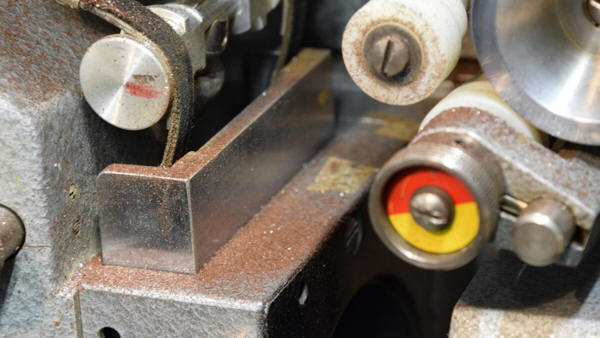 So
… We have done what maybe you would have done, or maybe not. We put it in
the machine, screened it, and it went through the machine okay. What we
initially observed, and what we confirmed, is that even though it looks like
it's going to fall apart on the rewind and that it can't be used, it will go
through in the machines. UMs are incredible machines. I warn in advance
those who are coming to see "Amadeus": concurrently with the
screening of 70mm we will not go 35mm but we will go digital. If it gets
ripped and blown up, we'll run digital. To illustrate one part, the
critical part: take a look at what the inside of the machine looks like after one single
"Amadeus" reel goes through. This is roughly what the magnetic
shedding looks like everywhere, all throughout the machine. It's just
unbelievable, this is what you see, you clean everything up, you re-set the
rollers and gate, the machine will be clean and ready to go. The next reel
is projected and it looks like this again. After every reel the magnetic
oxide falls off, falls off, falls off. It's just that the bonding layer
between the oxide and the celluloid is now useless. No other movie I've seen
so far has done that. And you can see that soundtrack, what it looks like.
That's what the entire soundtrack looks like today, for the entire length.
When it's playing, it's just absolutely terrible. In fact, I’ll say it
doesn't even look that good in some places. And I can confirm, we have
checked the other print, and it looks the same, so both prints have the
oxide falling off, not just one. So
… We have done what maybe you would have done, or maybe not. We put it in
the machine, screened it, and it went through the machine okay. What we
initially observed, and what we confirmed, is that even though it looks like
it's going to fall apart on the rewind and that it can't be used, it will go
through in the machines. UMs are incredible machines. I warn in advance
those who are coming to see "Amadeus": concurrently with the
screening of 70mm we will not go 35mm but we will go digital. If it gets
ripped and blown up, we'll run digital. To illustrate one part, the
critical part: take a look at what the inside of the machine looks like after one single
"Amadeus" reel goes through. This is roughly what the magnetic
shedding looks like everywhere, all throughout the machine. It's just
unbelievable, this is what you see, you clean everything up, you re-set the
rollers and gate, the machine will be clean and ready to go. The next reel
is projected and it looks like this again. After every reel the magnetic
oxide falls off, falls off, falls off. It's just that the bonding layer
between the oxide and the celluloid is now useless. No other movie I've seen
so far has done that. And you can see that soundtrack, what it looks like.
That's what the entire soundtrack looks like today, for the entire length.
When it's playing, it's just absolutely terrible. In fact, I’ll say it
doesn't even look that good in some places. And I can confirm, we have
checked the other print, and it looks the same, so both prints have the
oxide falling off, not just one.Here you can see a bit of the third and fifth reels, almost every other frame torn, taped up. Some of these parts, when they go through the projector, they do come off, and the tapes that are repaired around the edges, they stay in the machine, which we have to sweep out, vacuum up, etc. So I'm afraid that "Amadeus" will be having its final projection. There’s an old saying, “never say never”, but this film print is really in what I’d call terminal condition. This track decay you're seeing here would be quite audible in the sound of course, which we're not going to play. If you look at the far left track up at the top, those kind of gaps, or spaces, that's the damage. Each picture is one gap. And it's all over the entire movie. It's not like I showed you this one little problem spot. It's all over the whole place. So "Amadeus" had over 200 stickers (splices) in the whole movie, if not more. Just something terrible, so tomorrow it will be farewell to "Amadeus". So I thank you very much for putting up with me and these technical ramblings, and maybe understanding something of what we do. |
|
*Footnote “Dramaturgy” – meaning and discussion: |
|
|
Dramaturgy is the process and art of writing
and staging a play. Your little brother's preschool production of "The Three
Little Pigs" might not be an example of excellent dramaturgy, but it is
adorable. Playwrights, theater directors, and drama teachers are the most likely to throw around the term dramaturgy. It encompasses everything that's involved in creating a play and producing it on an actual stage for an audience to watch. Dramaturgy is especially focused on the play's setting, social context, political themes, and the psychology of its characters. The word itself comes from Greek roots drama and ergon, "work or activity." |
|
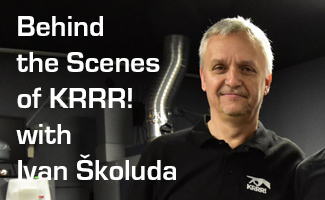 • Go to Behind the Scenes of KRRR! with Ivan Školuda |
|
| Go: back - top - back issues - news index Updated 22-01-25 |
